
Loc. Desc.: Bedrock in spillway exposed after the flood of 1993 (July 1993)
Measured by: Stephen A. Muehleisen
Date: 16 October 1993
Kansas Geological Survey, Open-file Rept. 94-36
Prev--Stromatolites ||
Next--Aviculopinna valves
Department of Geology, Kansas State University
Four samples of the Bennett Shale Member of the Red Eagle Limestone (Council Grove Group, Lower Permian) were collected from the Tuttle Creek Spillway exposure and analyzed for their trace and rare earth (REE) elemental compositions using instrumental neutron activation analysis. In addition, the elemental ratios of La/Sc, Th/Sc, La/Co, Th/Co, Ba/Co, La/Cr and Th/Cr were calculated for each sample.
The results were then compared graphically to the trace and rare earth element compositions of twelve samples of Middle to Upper Pennsylvanian black shales published by Schultz and Coveney, (1992). These represent the Mecca, transitional Heebner, Heebner, and the Shanghai-type black shales.
The interpreted environments of deposition for these representative Pennsylvanian shales is well accepted. By comparing the trace and rare earth element geochemistry of these shales with that of the Bennett shale, a possible depositional environment can be inferred. This inferred depositional environment is supported (though not conclusively) by the stratigraphy, biogenic structures and fossils of the Bennett seen at the Tuttle Creek Spillway exposure.
On the basis of the elemental compositions and outcrop data, the Bennett shale can be interpreted as a Lower Permian "Shanghai"-type black shale using the scheme of Schultz and Coveney (1992). When the elemental compositions and elemental ratios of the Bennett shale are compared to that of the Mecca, transitional-Heebner, Heebner, and Shanghai-type black shales it most closely fits the lagoonal, or Shanghai-type of black shale.
The presence and types of biogenic structures at both the upper and lower contacts with overlying and underlying strata show what is interpreted as a gradual change from shallow water carbonate (Glenrock ls.), to an organic-rich black shale (Bennett sh.) and then back to another shallow water carbonate unit (Howe ls.). In addition, the presence of phosphatic fossils (Orbiculoidea) within the Bennett shale is also characteristic of the Shanghai-type black shales. All this taken together with the discovery of fossil shark remains (Bobbodus schaefferi and Xenacanthus) lends further support to a hypothesis of a lagoonal environment of deposition.
The Bennett shale is the middle member of the Red Eagle Limestone of the Council Grove Group, Lower Permian. This unit is underlain by the Glenrock limestone and overlain by the Howe limestone. Both of these limestone units have been interpreted as shallow water carbonates (Olszewski, personal communication). This interpretation is based on the presence of crossbedding, evaporite dissolution vugs within, and stromatolites on the top of the Howe limestone. The Glenrock is interpreted as a shallow water carbonate based on its contained intraclasts (granule to pebble sized), and the fact that it directly overlies a tidal rhythmite facies (Schlagar, personal comminucation) in the uppermost part of the underlying Johnson Shale. (Figure 4.1).
Figure 4.1--Stratigraphic sequence of Red Eagle Limestone at Tuttle Creek Spillway.

|
Sec. 19, T. 9 S., R. 8 E.; County: Riley; State: KS; Scale: 1" = 35 cm Loc. Desc.: Bedrock in spillway exposed after the flood of 1993 (July 1993) Measured by: Stephen A. Muehleisen Date: 16 October 1993 |

|
Description (1) Roca Shale; varigated mudstone, mud cracks, numerous paleosols (2) Howe Limestone; brown to yellowish gray packstone-graystone, well sorted, coarse sand sized grains, dissolution vug with iron oxide filling. Gastropod and ostracode coquina along with stromatolites along upper contact. Sharp upper contact with Roca Shale. Lower portion of unit is cross bedded. (3) Bennett Shale; olive black (5Y2/1) fissile shale. Upper contact is sharp except where bioturbation has obscured the contact, burrows consist of Thalassinoides and Chondrites, Orbiculoidea in fossiliferous layers, fish fossils include Bobbodus schaefferi and Xenacanthus, calcite vein fill. Sharp lower contact. (4) Glennrock Limestone; medium light gray (N6), massive, granule to pebble sized rounded intraclasts, black shale filled burrows on upper surface. (5) Johnson Shale; dark gray (N3), calcareous, flaser bedded. |
The upper contact of the underlying Glenrock ls. contains Thalassinoides-like burrows similar to those seen in the upper part of the Bennett. The burrows are filled with a dark gray lithology that is interpreted as the beginning of Bennett shale deposition. This supports an argument for a somewhat gradual facies change. As organic rich siliciclastic sediment began to be deposited the Glenrock carbonate factory shutdown and its benthic fauna (brachiopods and crinoids) was smothered.
Thalassinoides-like burrows and Chondrites occur at the upper contact of the Bennett shale. The Thalassinoides-like burrows are filled with a carbonate shell hash, a lithology which closely resembles the lithology of the overlying Howe ls. This, and the Chondrites, argue for a gradual decrease in anoxia that eventually allowed a benthic fauna to develop and establish a carbonate factory that eventually lead to the formation of the Howe ls.
The origin of the Bennett and other Lower Permian and Pennsylvanian black shales has been enigmatic. The cyclothem model (Heckel, 1977) intreprets these shales as the "core shale" member of the Kansas-type cyclothem. According to this model these dark (gray to black) shales were deposited in a deep, offshore, anoxic environment during the high-stand of a transgressive sea level change.
This model is not accepted by some (Archer and Kvale, 1993), who have difficulty with the deep, offshore part of this model. Additionally, the Pennsylvanian black (to gray) shales often overlie coal beds. These workers prefer a model favoring a shallow, nearshore environment. In their model the shale's dark color comes from terrestrial organic matter derived from flooded peat bogs and coal swamps rather than the slow accumulation of open marine organic matter.
In the case of the Bennett shale, for example, the characteristics of the overlying and underlying rocks are clearly at odds with the model proposed by Heckel (1977). To put a deep water facies between two shallow water facies would require a transgressive-regressive eustatic change of extreme magnitude, all within Bennett shale, all without the deposition of any intermediate transitional facies. A situation such as this seems very unlikely. On the other hand, the recent recovery of marine vertebrate remains (sharks) (Schultze and West, in review) at the Tuttle Creek Spillway exposure casts serious doubt on the Bennett shale being the result of a flooded peat bog, or coal swamp.
It is the resolution of this question that this project hopes to alleviate by comparing the trace and rare earth elemental composition of the Bennett shale to other black shales of known composition and whose inferred environment of deposition is more widely accepted.
Schultz and Coveney (1992) examined black shales from the midcontinent Pennsylvanian and classified them into four types, the Mecca-type, the transitional Heebner-type, the Heebner-type, and the Shanghai-type. Mecca-type shales are interpreted as having been deposited in a nearshore environment, with terrestrial organic matter (i.e., from flooded peat bogs and coal swamps). The Heebner-type shale is interpreted as being an offshore facies with marine organic matter. The transitional-Heebner type is transitional between the Mecca and the Heebner types, and the Shanghai-type shale is interpreted as being deposited in an isolated, lagoonal environment with both marine and terrestrially organic matter.
Four samples of the Bennett shale were taken from the exposure at the Tuttle Creek Spillway. Two of the samples (#1 WR and #2 WR) were grab samples obtained in the fall of 1993, during the extraction of the Bobbodus schaefferi. The other two (S1 WR and S2 WR) were removed from the Bennett shale exposure just below the bioturbated interval (S1 WR) and just above the contact with the Glenrock ls. (S2 WR) (Figure 4.1).
These samples were then ground in an onyx mortar and pestle until they could pass through a 120 mesh sieve. The samples were then placed in 1 gm clear plastic vials and irradiated in a Triga Mark 3 experimental nuclear reactor (neutron source) for 4 hours at full power and then analyzed according to instrumental neutron activation methods following Jacobs, et al. (1977).
Determination of the trace and rare earth elemental compositions of samples #1 WR, #2 WR, S1 WR and S2 WR were then completed and the ratios of certain elements were computed. These results are tabulated in Table 4.1 and compared to data from Schultz and Coveney (1992), which is also included in Table 4.1. The comparison to the Schultz and Coveney (1992) data was done graphically. Time constraints precluded the detailed statistical work that is warranted.
| Element | Standards | Wolfcampian (Lower Permian) Bennett Shale Samples |
Desmoinesian (Middle Pennsylvanian) Mecca-type black shales |
Desmoinesian (Middle Pennsylvanian) Transitional Heebner-type shales |
Missourian (Upper Pennsylvanian) Heebner-type shales |
Virgillian (Upper Pennsylvanian) |
||||||||||||
|---|---|---|---|---|---|---|---|---|---|---|---|---|---|---|---|---|---|---|
| Heebner-type shales | Shanghai-type shales | |||||||||||||||||
| NASC | SDO-1 | #1 WR | #2 WR | S1 WR | S2 WR | 73 | 21 | 18 | 61 | 55 | 44 | 79 | 80 | HB5 | QH1 | SH1 | SH2 | |
| Rb | 125 | 126 | 152.70 | 133.80 | 118.00 | 111.00 | 85.00 | 81.00 | 3.00 | 71.00 | 75.00 | 113.00 | 115.00 | 97.00 | 120.00 | 150.00 | 180.00 | 190.00 |
| Ba | 636 | 397 | 303.00 | 295.00 | 237.00 | 215.00 | 300.00 | 290.00 | 240.00 | 155.00 | 200.00 | 360.00 | 190.00 | 260.00 | 340.00 | 370.00 | 400.00 | 450.00 |
| Th | 12.3 | 10.5 | 11.00 | 10.00 | 9.60 | 8.30 | 6.50 | 6.50 | 6.20 | 5.60 | 7.00 | 10.10 | 8.70 | 7.60 | 8.70 | 9.00 | 12.00 | 13.00 |
| Hf | 6.3 | 4.7 | 3.20 | 3.10 | 2.60 | 2.20 | 2.00 | 1.90 | 1.70 | 1.80 | 2.00 | 3.50 | 3.10 | 2.90 | 3.20 | 3.00 | 4.00 | 4.00 |
| Ta | 1.12 | 1.0 | 1.19 | 1.06 | 1.12 | 0.94 | 1.40 | 0.50 | 0.80 | 0.60 | 0.70 | 1.20 | 0.90 | 0.90 | 1.00 | 1.00 | 1.00 | 1.00 |
| Co | 25.7 | 46.8 | 9.80 | 9.10 | 7.90 | 7.40 | 23.00 | 21.00 | 25.00 | 11.00 | 12.00 | 22.00 | 14.00 | 12.00 | 14.00 | 12.00 | 19.00 | 11.00 |
| Sc | 14.9 | 13.2 | 12.50 | 11.80 | 10.70 | 9.10 | 12.00 | 11.00 | 11.00 | 9.00 | 10.00 | 14.00 | 13.00 | 12.00 | 14.00 | 12.00 | 18.00 | 17.00 |
| Cr | 124.5 | 66.4 | 633.00 | 596.00 | 475.00 | 433.00 | 610.00 | 490.00 | 300.00 | 370.00 | 920.00 | 500.00 | 540.00 | 570.00 | 680.00 | 910.00 | 360.00 | 380.00 |
| Cs | 5.16 | 6.9 | 8.60 | 7.70 | 7.00 | 6.50 | 5.00 | 4.00 | 4.00 | 4.00 | 5.00 | 7.00 | 7.00 | 6.00 | 7.00 | 6.00 | 9.00 | 10.00 |
| La | 32.0 | 38.5 | 38.90 | 35.80 | 36.20 | 34.40 | 43.00 | 31.00 | 31.00 | 44.00 | 31.00 | 42.00 | 39.00 | 40.00 | 33.00 | 26.00 | 46.00 | 37.00 |
| Ce | 73.0 | 79.3 | 50.50 | 48.40 | 46.40 | 34.00 | 59.00 | 54.00 | 52.00 | 63.00 | 61.00 | 81.00 | 80.00 | 66.00 | 2.00 | 48.00 | 85.00 | 56.00 |
| Sm | 5.7 | 7.7 | 6.61 | 5.90 | 7.21 | 5.26 | 8.50 | 7.10 | 5.10 | 8.60 | 7.80 | 8.40 | 9.00 | 8.80 | 5.70 | 3.90 | 8.20 | 3.20 |
| Eu | 1.24 | 1.6 | 1.23 | 1.11 | 1.14 | 0.86 | 1.80 | 1.70 | 1.10 | 1.90 | 1.60 | 1.80 | 2.00 | 1.70 | 2.00 | 0.70 | 1.80 | 0.80 |
| Tb | 0.9 | 1.2 | 0.83 | 0.69 | 1.06 | 0.63 | 1.10 | 1.30 | 0.80 | 1.40 | 1.10 | 1.30 | 1.20 | 1.20 | 1.10 | 0.50 | 1.20 | 0.40 |
| Yb | 3.1 | 3.4 | 2.92 | 2.47 | 2.64 | 2.19 | 3.60 | 3.20 | 2.40 | 4.30 | 4.10 | 4.70 | 3.50 | 3.40 | 2.90 | 2.00 | 2.90 | 1.90 |
| Lu | 0.48 | 0.54 | 0.67 | 0.59 | 0.42 | 0.36 | 0.60 | 0.50 | 0.30 | 0.70 | 0.60 | 0.90 | 0.60 | 0.50 | 0.50 | 0.10 | 0.05 | 0.02 |
| Element ratios |
NASC | SDO-1 | #1 WR | #2 WR | S1 WR | S2 WR | 73 | 21 | 18 | 61 | 55 | 44 | 79 | 80 | HB5 | QH1 | SH1 | SH2 |
| La/Sc | 2.15 | 2.92 | 3.11 | 3.03 | 3.38 | 3.78 | 3.58 | 2.82 | 2.82 | 4.89 | 3.10 | 3.00 | 3.00 | 3.33 | 2.36 | 2.17 | 2.58 | 2.18 |
| Th/Sc | 0.83 | 0.80 | 0.88 | 0.85 | 0.90 | 0.91 | 0.54 | 0.59 | 0.56 | 0.62 | 0.70 | 0.72 | 0.67 | 0.63 | 0.62 | 0.75 | 0.67 | 0.76 |
| La/Co | 1.25 | 0.82 | 3.97 | 3.93 | 4.58 | 4.65 | 1.87 | 1.48 | 1.24 | 4.00 | 2.58 | 1.91 | 2.79 | 3.33 | 2.36 | 2.17 | 2.42 | 3.36 |
| Ba/Sc | 42.68 | 30.08 | 24.24 | 25.00 | 22.15 | 23.63 | 25.00 | 26.36 | 21.82 | 17.22 | 20.00 | 25.71 | 14.62 | 21.67 | 24.29 | 30.83 | 22.22 | 26.47 |
| Ba/Co | 24.75 | 8.48 | 30.92 | 32.42 | 30.00 | 29.05 | 13.04 | 13.81 | 9.60 | 14.09 | 16.67 | 16.38 | 13.57 | 21.67 | 24.29 | 30.83 | 21.05 | 40.91 |
| La/Cr | 0.2570 | 0.5798 | 0.0615 | 0.0600 | 0.0761 | 0.0794 | 0.0705 | 0.0633 | 0.1033 | 0.1189 | 0.0337 | 0.0840 | 0.0722 | 0.0702 | 0.0500 | 0.0286 | 0.1278 | 0.0974 |
| Th/Cr | 0.0988 | 0.1581 | 0.0174 | 0.0168 | 0.0202 | 0.0192 | 0.0107 | 0.0133 | 0.0207 | 0.0151 | 0.0076 | 0.0202 | 0.0161 | 0.0133 | 0.0132 | 0.0099 | 0.0333 | 0.0342 |
From the graphs of the elemental compositions several things are obvious (Figures 4.2-4.6). The first is the rather large Cr peak. This is ubiquitous to all the samples from the Bennett shale and the sample data provided by Schultz and Coveney (1992). This possibly shows preferential enrichment of Cr in the shales caused by the adsorption of Cr on clay minerals during deposition (Condie and Wronkiewicz, 1990). Cr is susceptible to the effects of weathering and sedimentation (Condie and Wronkiewicz, 1990) and is most probably allogenic in origin. The high concentrations are the result of enrichment through re-working and subaqueous weathering of the sediments producing minerals capable of uptaking and retaining Cr. Examination of the clay mineralogy of the Bennett shale shows the presence of illite (coarse clay fraction) and vermiculite (fine clay fraction) and, perhaps, small amounts of kaolinite. (Muehleisen, unpublished data) Further INAA work will determine the Cr content in the clay fraction and the ratio of this to the amounts of Cr present in the whole rock.
Figure 4.2--Trace and rare-earth element content of Mecca-type shales; data from Schultz and Coveney, 1992.
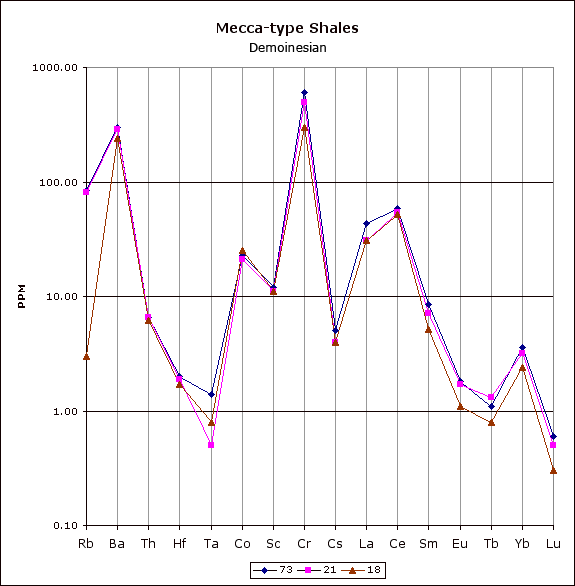
Figure 4.3--Trace and rare-earth element content of transitional Heebner-type shales; data from Schultz and Coveney, 1992.
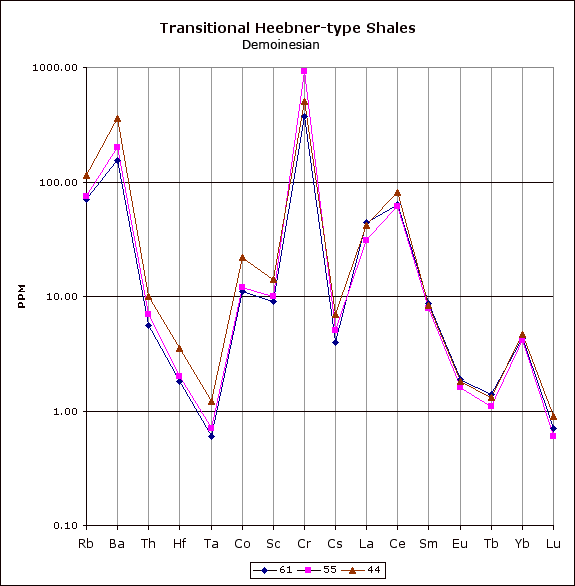
Figure 4.4--Trace and rare-earth element content of Heebner-type shales; data from Schultz and Coveney, 1992.
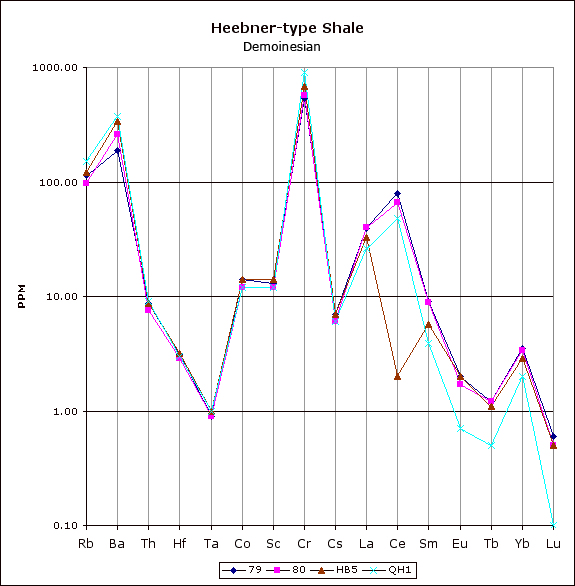
Figure 4.5--Trace and rare-earth element content of Shanghai-type shales; data from Schultz and Coveney, 1992.
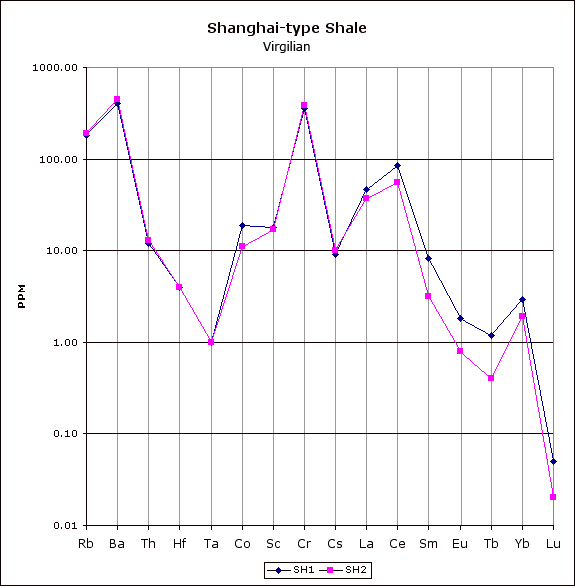
Figure 4.6--Trace and rare-earth element content of Bennett shale; this study.
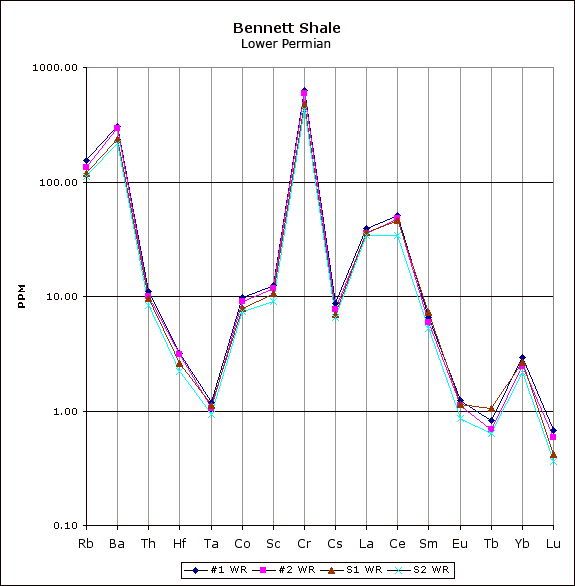
At the Tuttle Creek Spillway exposure the Bennett shale contains sufficient organic matter to burn when held in a flame. A simple "Bic" type cigarette lighter provides a flame hot enough to ignite the Bennett shale. Desborough, Hatch and Leventhal (1989) in their work have associated Cr and other heavy metals with organic matter. Unfortunately, the facilities necessary for analysis of the organic matter contained in the Bennett shale were unavailable.
Schultz and Coveney (1992) analyzed samples from a stratigraphic interval extending from the Desmoinesian (Middle Pennsylvanian) to the Virgilian (Upper Pennsylvanian). The Mecca-type and the transitional Heebner-type shales are the oldest, Desmoinesian (Middle Pennsylvanian), and are approximately the same age. Heebner-type black shales are Missourian (Upper Pennsylvanian) and Virgilian (Upper Pennsylvanian). Shanghai-type black shales are Virgilian (Upper Pennsylvanian). The Bennett Shale, Wolfcampian, (Lower Permian) is younger than any shales analyzed by Schultz and Coveney (1992).
When arranged in this order it can be seen that the Co levels steadily decline with time relative to the amounts of the other elements. This is especially apparent when comparing the Bennett shale to the Mecca-type shales (youngest to oldest). This warrants further study as it is possible that from the Desmoinesian to the Wolfcampian changing paleo-environmental conditions (tropical to arid) effected sediment sourcing and/or weathering profiles.
Using the same chronological arrangement of the graphs of the elemental ratios the change in the shape of the peak defined by the Ba/Sc and Ba/Co ratios can be seen (Figures 4.7 - 4.11). This change in the apex of the peak from Ba/Sc to Ba/Co reflects the changes in Co content over time. Whether this is, indeed, a steady, time dependent trend remains to be determined. A comparison of the trace element and REE contents of the dark, organic shales from oldest to youngest needs to be made.
Figure 4.7--Elemental ratios of trace and rare-earth elements from Mecca-type shales; data from Schultz and Coveney, 1992.
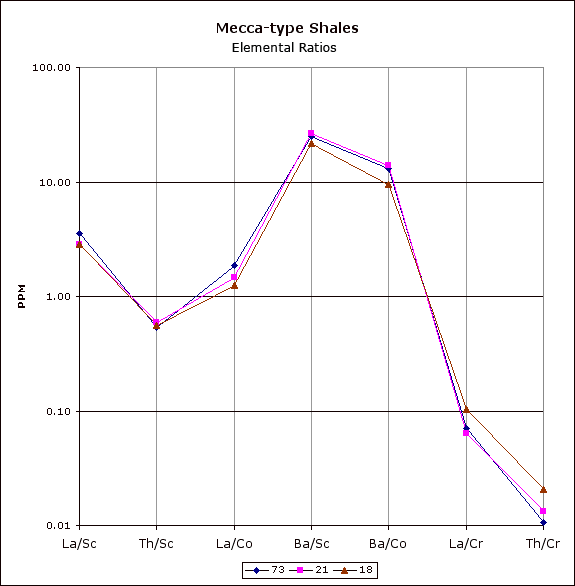
Figure 4.8--Elemental ratios of trace and rare-earth elements from transitional Heebner-type shales; data from Schultz and Coveney, 1992.
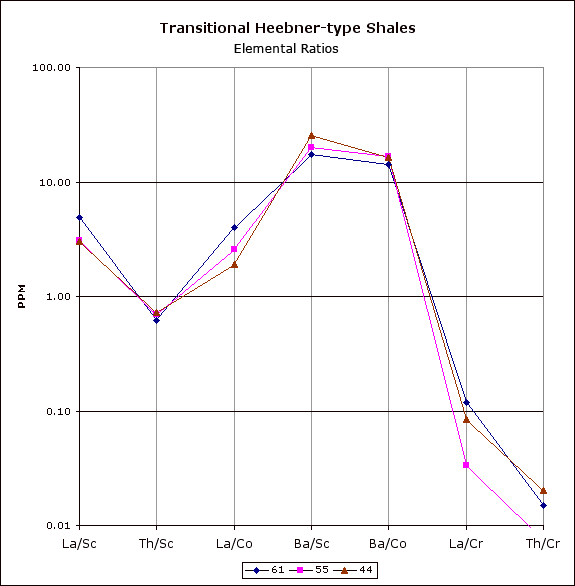
Figure 4.9--Elemental ratios of trace and rare-earth elements from Heebner-type shales; data from Schultz and Coveney, 1992.
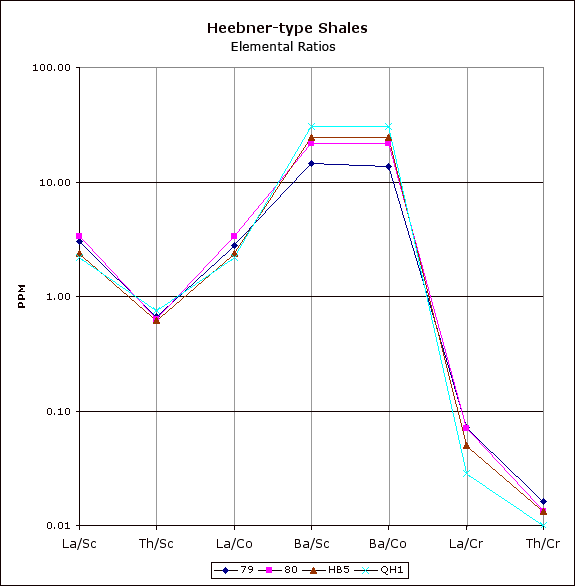
Figure 4.10--Elemental ratios of trace and rare-earth elements from Shanghai-type shales; data from Schultz and Coveney, 1992.
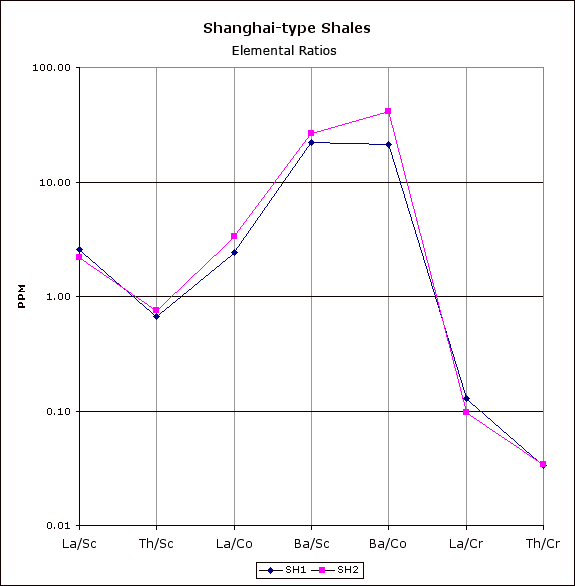
Figure 4.11--Elemental ratios of trace and rare-earth elements from Bennett shale; this study.
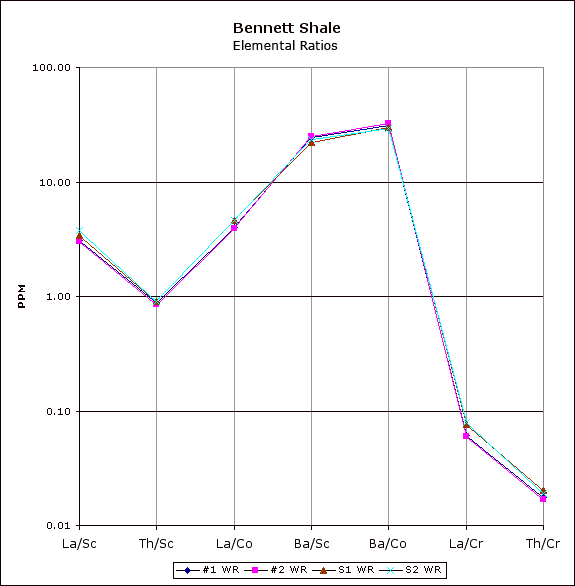
In addition, the remarkable agreement of the elemental ratios in the Bennett shale to the elemental ratios of the Shanghai-type shales can readily be seen (Figure 4.12). This is interpreted as showing the Bennett Shale to be of the Shanghai-type of black shale, using the scheme of Schultz and Coveney (1992). This interpretation is supported by the interpretation of gradual facies change due to the location and the types of biogenic structures present in both the Bennett shale and Glenrock ls. and the presence of phosphatic fossils (Orbiculoidea), which is also characteristic of the Shanghai-type black shales. In addition, the discovery of shark remains (Bobbodus schaefferi and Xenacanthus) lends further support to a shallow lagoonal environment with at least restricted access to the sea.
Figure 4.12--Comparison of elemental ratios of trace and rare-earth elements from the Bennett shale with those from Shanghai-type shales.
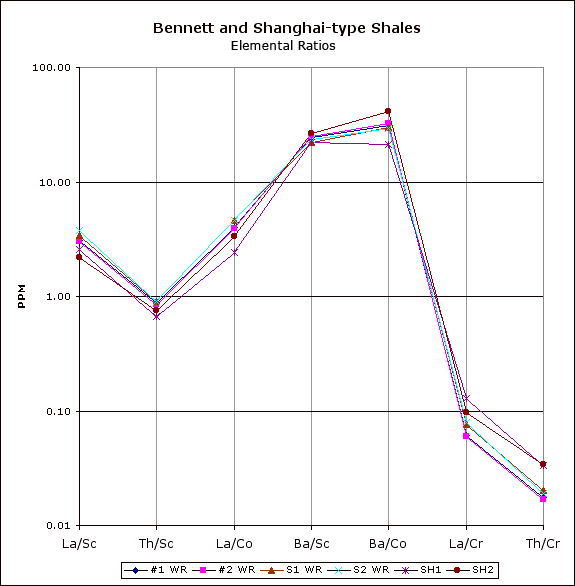
A shallow lagoonal setting is appropriate for the genesis of the Bennett shale. Because of the similarities between its geochemistry and that of the Shanghai-type black shale the following model of deposition for the Bennett shale is suggested.
During a glacio-eustatic driven transgression of relative sea level (Heckel, 1986) the tidal facies of the uppermost Johnson Shale would migrate landward while the paleo-spillway location would become a shoal calcarenite (Heckel, 1990) due to wave action. This and other factors controlling carbonate production and sedimentation lead to the formation of the Glenrock limestone, the basal unit in the Red Eagle Limestone. Continued transgression and, possibly, subsidence of the basin caused the location to begin to receive organic detrital influx, most likely from both marine and terrestrial sources. This influx of organic matter initially began to stress the existing benthic fauna (i.e., filling burrows, suffocating brachiopods), and finally, with continuing organic influx leading to the creation of an anoxic environment, smothering it completely.
At this point it is necessary to point out that at maximum high stand of the transgression the water depth need not be excessive. All that is required is sufficient depth to create a shallow but laterally widespread lagoon. Anoxia, sufficient to preclude a benthic fauna from developing, would be provided by the influx of marine and terrestrial organic matter. McCrone (1963) documented the presence of conodonts, particularly Streptognathodus (= Idiognathodus of Baesemann, 1973) Therefore, it is likely that the zone of anoxia may have only extend upward to just slightly above the water-substrate interface.
This lagoonal environment would provide a somewhat sheltered environment that would allow the formation of large floating algal mats to form and provide a substrate, of sorts, for colonization by Orbiculoidea in the upper oxygenated part of the water column. Orbiculoidea could, in turn, provide a food source for pelagic organisms such as Bobbodus schaefferi. In addition the algal mats, themselves, could also be substantial contributors to the total organic content of the Bennett shale. Regretfully, it was not possible to quantify the make up of the organic content of the Bennett shale (Porter, personal communication) in this study.
Moore, et al. (1951) mentioned in their description of the Red Eagle Limestone that the Bennett shale grades into limestone south of Elk County, KS. This is interpreted as the southern margin of the paleo Bennett lagoon, where the water-substrate interface rose above the anoxia boundary and into conditions favorable for carbonate production. In addition, they mentioned that the Red Eagle limestone forms a single ledge about twenty feet thick in southern Kansas, but that the two limestone members that are differentiated in central and northern Kansas (the Glenrock and Howe members) can also be identified in southern Kansas. This can be interpreted as evidence for two temporally distinct periods of carbonate deposition that extended beyond the margins of the anoxic part of the Bennett lagoon.
During glacio-eustatic regression, the paleo-Bennett lagoon would drain sufficiently to allow the oxygenated part of the water column to reach the lagoon's bottom (upper surface of the Bennett shale). This would allow a new benthic community to colonize the surface and eventually a new carbonate factory would be established leading to the formation of the Howe ls. Further regression and aridity lead to the creation of a sabka-like environment with the stromatolites that characterize the upper surface of the Howe ls. Later the Rocca Shale was deposited.
Archer, A.W., and Kvale, E.P., 1993, Origin of Grey-shale Lithofacies ("Clastic Wedges") in U.S. Midcontinent Coal Measures (Pennsylvanian): an Alternative Explanation: Kansas Geological Survey, Open-File Rept. 93-24, chapt. 14.
Baesemann, J.F., 1973, Missourian (Upper Pennsylvanian) conodonts of northeastern Kansas: Jour. Paleontology, v. 47, p. 689-710.
Condie, K.C., and Wronkiewicz, D.J., 1990, The Cr/Th ratio in Precambrian pelites from the Kaapvaal Craton as an index of craton evolution: Earth and Planetary Science Letters, v. 70, p. 267-279.
Desborough, G.A., Hatch, J.R., and Leventhal, J.S., 1989, Geochemical and mineralogical composition of the Upper Pennsylvanian Stark Shale Member of the Dennis Limestone, east-central Kansas, with the Middle Pennsylvanian Mecca Quarry Shale Member of the Carbondale Formation in Illinois and of the Linton Formation in Indiana, in Grauch, R.I. and Huyck, H.L.O., eds., Metalliferous Black Shales and Related Ore Deposits--Proceedings, 1989 United States Working Group Meeting, International Geological Correlation Program Project 254: U.S. Geological Survey, Circular 1058, p. 12-30.
Heckel, P.H., 1977, Origin of phosphatic black shale facies in Pennsylvanian cyclothems of the mid-continent North America: Am. Assoc. Pet. Geol. Bull., v. 61, p. 1045-1068.
Heckel, P.H., 1986, Sea-level curve for Pennsylvanian eustatic marine transgressive-regressive depositional cycles along midcontinent outcrop belt: North American Geology, v. 14, p. 330-334.
Heckel, P.H., 1990, Evidence for global (glacial-eustatic) control over upper Carboniferous (Pennsylvanian) cyclothems in midcontinent North America, in Hardman, R.F.P. and Brooks, J., eds., Tectonic Events Responsible for Britain's Oil and Gas Reserves: Geological Society (London), Special Publication, v. 55, p. 35-47.
Jacobs, J.W., Korotev, R.L., Blanchard, D.P. and Haskin, L.A., 1977, A well tested procedure for instrumental neutron activation analysis of silicate rocks and minerals: J. Radioanal. Chem., v. 40, p. 93-114.
McCrone, A.W., 1963, Paleoecology and biostratigraphy of the Red Eagle cyclothem (Lower Permian) in Kansas: Kansas Geol. Survey, Bull. 164, 114 p. [available online]
Moore, R.C., Frye, J.C., Jewtt, J.M., Lee, W., O'Conner, H.G., 1951, The Kansas Rock Column: Kansas Geol. Survey, Bull. 89, 132 p. [available online]
Schultz, R.B., and Coveney, Jr., R.M., 1992, Time-dependent changes for Midcontinent Pennsylvanian black shales, U.S.A: Chem. Geol., v. 99, p. 83-100.
Schultze, H.-P. and West, R. R., 1996, An eugeneodontid elasmobranch from the late Paleozoic in Kansas: Journal of Paleontology, vol. 70, no. 1, p. 162-165.
Prev--Stromatolites || Next--Aviculopinna valves
Kansas Geological Survey, Geology
Placed on web Feb. 27, 2007.
Comments to webadmin@kgs.ku.edu
The URL for this page is http://www.kgs.ku.edu/Publications/OFR/1994/OFR94_36/page4.html